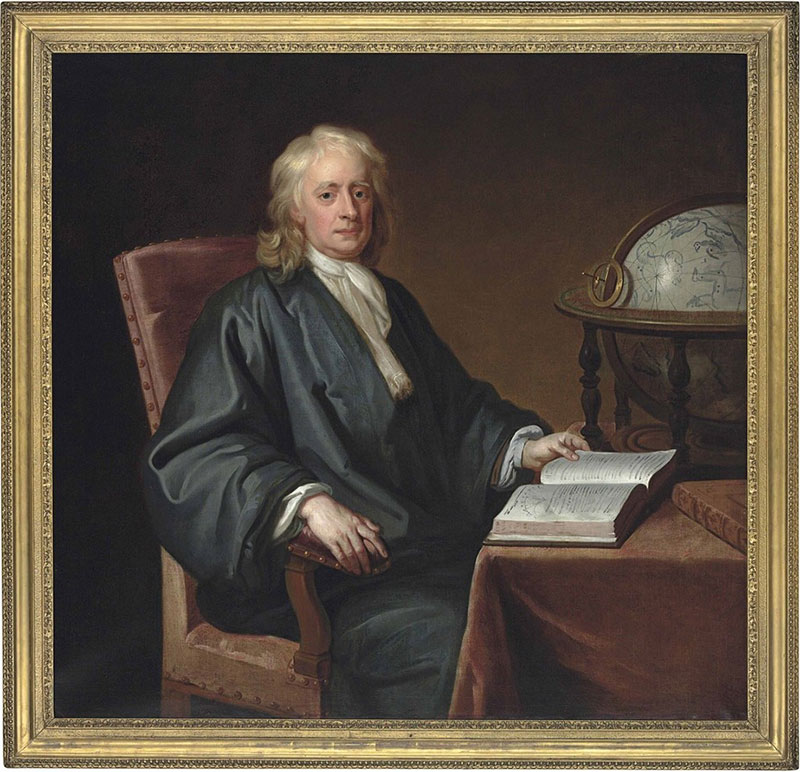Some fairly random notes and illustrations of the portraits and busts of Isaac Newton.
The entries on the portrait sculpture of Isaac Newton in this blog are intended to complement and expand on the excellent work of Milo Keynes.
see - The Iconography of Isaac Newton, Milo Keynes, Cambridge, 2005.
The entries on the portrait sculpture of Isaac Newton in this blog are intended to complement and expand on the excellent work of Milo Keynes.
see - The Iconography of Isaac Newton, Milo Keynes, Cambridge, 2005.
I will edit and repost this information on my main blog in due course. This might take some time.
I apologise for the amateurishness.
I apologise for the amateurishness.
see -
I am currently using this blog as an aide memoire and somewhere to file information.
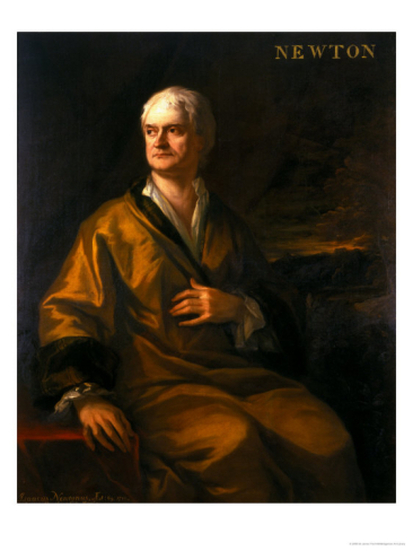
Sir Isaac Newton
by Sir James Thornhill
102 x 122 cms.
c. 1710.
Trinity College, Cambridge.
_______________________________________
_______________________________________

Newton by Thornhill
127 x 101.2 cms
In the Study Woolsthorpe Manor Lincs.
c1709 /12
National Trust.
_______________________________________
_______________________________________
Mezzotint of Isaac Newton
by and published by John Simon, after Sir James Thornhill
mezzotint, circa 1700-1725.
13 7/8 in. x 9 7/8 in. (352 mm x 252 mm) paper size.
________________________________
mezzotint, circa 1700-1725.
13 7/8 in. x 9 7/8 in. (352 mm x 252 mm) paper size.
________________________________
The David Le Marchand Ivory Busts of Isaac Newton.

Possibly David le Marchand (1674 - 1726) with the Ivory bust of Isaac Newton.
by Joseph Highmore (1692 - 1780).
Oil on canvas, circa 1723.
48 3/4 in. x 39 1/4 in. (1240 mm x 997 mm)
Purchased, 1991
NPG 6142
48 3/4 in. x 39 1/4 in. (1240 mm x 997 mm)
Purchased, 1991
NPG 6142
© National Portrait Gallery, London
by David le Marchand.
Signed and dated on the small marble pedestal
Inscribed D.L.M. Sct. 1714.
Inscribed D.L.M. Sct. 1714.
186 mm.
Provenance Lord Halifax (Sold Cocks, Covent Garden 1739)
2nd Earl of Oxford (1689 - 1741),Wimpole Hall Cambridge.
James West (Sale Langfords London 6 March 1773 lot 19
Countess of Gosford 1930's bought from dealers Alfred Spero
Presented to the Gallery in 1939.
George Vertue in his notebooks describes a bust with the same date in the sale of the pictures of Lord Halifax.
National Gallery of Victoria, Australia.
______________________
______________________
British Museum bust of Isaac Newton
by David le Marchand

2. The Raper Ivory Bust of Isaac Newton
David le Marchand
Signed and dated -
ISAACUS NEWTON/EQ:AVRA/ An:1718:/le Marchand/Sc. ad
vi.
Height 248 x width 151 x depth x 140 mm.
Given to the Museum by Matthew Raper III, FRS.
British Museum.
The Rysbrack Conduitt Bust of Newton and its versions are derived from this bust
Originally paired with a bust of John Locke (see below).
The bust was carved from life from a single elephant tusk in 1718, and is one of Le Marchand's most striking and famous works. The ivory, taken from the broader lower zone of an exceptionally large tusk, is particularly pleasing in colour. The work appears to be the bust shown in a painting of the carver by Joseph Highmore dating from around 1723.(above).
This bust and other ivory portraits of Newton by the same artist are fully discussed by Charles Avery, who comments that it was probably commissioned by the Rapers, either by Matthew Raper, the donor's father, or by Moses, his uncle. Both men were merchants with strong connections to the Bank of England.
Alternatively, the Museum bust may be the one commissioned by Newton, which after his death was recorded as having cost him one hundred guineas. The entry in one of George Vertue's note books records 'a head of Sr. Isaac Newton, carvd. in Ivory, pretty large, bald head - by. Le Marchand. 1718', which Vertue evidently saw not long after it was done.
Text above from - British Museum Website.
For an in depth study of le Marchand see - Charles Avery - David le Marchand, 1674-1726: 'an
ingenious man for carving in ivory', pub. Lund Humphries, London, 1996.
For the busts of Isaac Newton see - Milo Keynes, The Iconography of Sir Isaac Newton, pub Boydell, 2005.
For the British Museum Ivory Bust of Newton and a plaster bust by Rysbrack see Aileen Dawson, Portrait Sculpture, A catalogue of the British Museum Collection c. 1675 - 1975. pub British Museum Press, 1999.
For the Early le Marchand ivory portrait reliefs of the Mackenzie family of 1696, made in Edinburgh just after his arrival in Scotland see -




3. Bust of Isaac Newton
Le Marchand (possibly after) or studio of.
Bought Sotheby's lot 7, 26 March 1965
19 cms
Ivory
Collection of Lord Thompson of Fleet. Toronto, Canada.
NB the lack of shirt featured in the Raper bust.
This bust is now Paired with the bust of Locke below.
_______________________________
The once presumed lost Ivory bust of John Locke by Le Marchand,
215 mm.
The pair to Rapers bust of Newton by le Marchand.
Provenance The Raper family, Alfred Morrison, Mrs Michael Wright, 3 Barton St, London, SW1
This photograph was taken when the bust was lent to the Victoria and Albert Museum for study in 1936.
see - Charles Avery - David le Marchand, 1674-1726: 'an ingenious man for carving in ivory', pub. Lund Humphries, London, 1996.
________________________________
3. Bust of Isaac Newton
Le Marchand (possibly after) or studio of.
Bought Sotheby's lot 7, 26 March 1965
19 cms
Ivory
Collection of Lord Thompson of Fleet. Toronto, Canada.
NB the lack of shirt featured in the Raper bust.
This bust is now Paired with the bust of Locke below.
Ivory bust of John Locke
now paired with the bust of Newton (above)
20 cms.
Purchased from Alfred Speelman in 1953
Collection of Lord Thompson of Fleet. Toronto, Canada.
This would appear to be the missing Ivory bust of Locke above.
_________________________________

This would appear to be the missing Ivory bust of Locke above.
_________________________________

3. Bust of Isaac Newton
Le Marchand (possibly after) or studio of.
Bought Sotheby's lot 7, 26 March 1965
19 cms
Ivory
Collection of Lord Thompson of Fleet. Toronto, Canada.
NB the lack of shirt featured in the Raper bust.
This bust is now Paired with the bust of Locke below.
_________________________________
Isaac Newton
Lord Thompson of Fleet Collection
Art Gallery of Ontario. Toronto, Canada
197.5 x 130 mm.
Provenance: Dr Richard Meade - sold 11 March 1755 by A. Langford in association with Samuel Baker
____________________________________
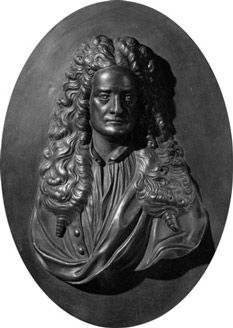
A Small relief of Isaac Newton
Cast from the ivory by le Marchand.
Babson Collection. USA.
___________________________



___________________
The Roubiliac Terracotta of Isaac Newton.
National Maritime Museum Greenwich.
National Maritime Museum Greenwich.
______________________________________
Marble Bust by Roubiliac
Royal Society.
On Newton's death in 1727, his nephew, John
Conduitt, allowed John Rysbrack to take casts of his face. Two of these were
obtained by Roubiliac and in about 1731 Conduitt commissioned him to make this
terracotta bust from them. It was later owned by the
surgeon John Belchier FRS, who at his death in 1785 left it to the Royal
Society with instructions that it should be placed in the Royal Observatory at
Greenwich.
In his will Belchier also stated that, as a portrait, it was
'esteemed more like than anything extant of Sir Isaac'. Some forty to fifty
years later, at Greenwich, the head was broken off in an accident and, after
being repaired, the whole was painted white. The result was that by the later
19th century the bust was mistaken for a low-value plaster one and it remained
at the Observatory up to and throughout the Second World War, on occasions
provided with a tin hat, before moving to Herstmonceux with the Royal Greenwich
Observatory (RGO) organization in the 1950s. The original was considered 'lost'
until the error was discovered in 1961, when it was stripped of paint and
expertly restored by the British Museum. After the RGO later moved to
Cambridge, it was lent to the Fitzwilliam Museum, mainly for safety. It
returned to Greenwich and the NMM's custody on the closure of the RGO in 1998.
__________________________
Marble bust of Sir Isaac Newton
by Louis Francois Roubiliac
With the Royal Society since 1738.
__________________________________

Another version of the Roubiliac bust of Newton
From a Lincolnshire Collection. see:
http://www.thecollectionmuseum.com/?/exhibitions-and-events/gallery/lincolnshires-great-exhibition
_____________________________________
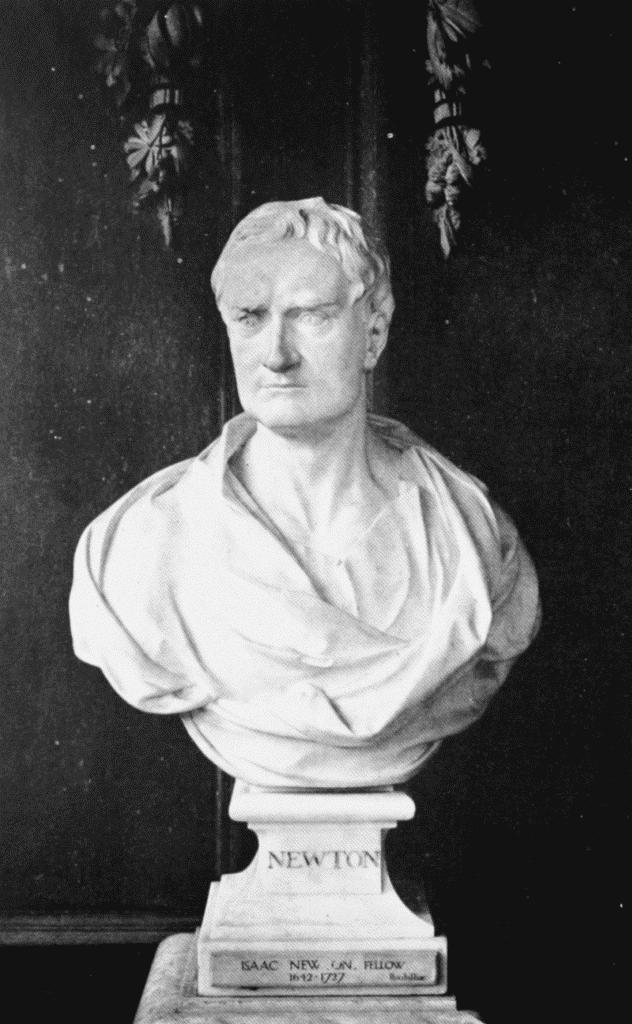
Isaac Newton
Life size marble bust.
1759.
by Louis Francois Roubiliac
Trinity College, Cambridge
Plaster cast of the Roubiliac Newton at Trinity College, Cambridge - origins obscure.
Institute of Astronomy Library.
___________________________________

Silver Medallion by John Croker (1670 - 1741). dated 1726.
on the reverse side - FELIX . COGNOSCERE . CAVSAS.
Happy in the knowledge of causes
Diam. 51 mm.
Croker was born in Dresden, moved to England in 1691, worked at the Royal Mint from 1697 -
Croker became chief engraver at the Royal Mint in 1705.
The dress of Newton is very similar that on the le Marchand ivory bust and it possible that it was the source, but the bust by Rysbrack although generally assumed to be later could also have provided the source for this relief. The hair above the forehead is certainly closer to the Rysbrack version but it is equally possible that it was the source for Rysbrack's bust.
The reverse side is repeated on the unusual base of Rysbrack's Conduitt bust of Newton and represents science holding a diagram of the Solar System.
Bronze Medallion of Isaac Newton by John Croker (1670 - 1741). dated 1726.
on the reverse side - FELIX . COGNOSCERE . CAVSAS.
Happy in the knowledge of causes.
Diam. 51 mm.
British Museum
______________________________________
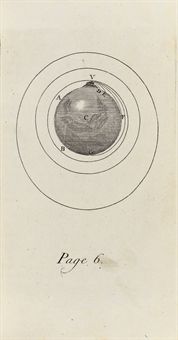
From A Treatise of the System of the World. Isaac Newton, London: for F. Fayram, 1728.
____________________________________
The Conduitt Marble Bust of Isaac Newton
by Michael Rysbrack.
With the base showing Science holding a diagram of the Solar System.
According to George Vertue (Note Books III), 1732 Mr Rysbrake did Sir Isaac Newton immediately after his death, from pictures or draughts - he does not mention a death mask.
The bust was commissioned by John Conduitt FRS (1688 - 1737).
Katherine Esdaile had claimed that the bust was by Roubiliac but she was unaware of the signed version of the bust at Trinity College Cambridge.
This mistake was repeated by David Bindman and by Malcolm Baker in Roubiliac and the Eighteenth Century Monument. pub by Yale 1995.
I had pointed out this mistake to Malcolm Baker sometime in 2000, but he goes on to repeat the assertion in The Marble Index. published by Yale in 2015
A very fine plaster version of the Rysbrack bust of Isaac Newton.
sold at Christie's Lot 105 - 5th December 2013.
59.7 cms
The catalogue suggests that it is the same as the version in the British Museum but even a cursory glance tells us that it is a much finer cast. Unfortunately there is not a photograph of the back.
It is very close to the plaster version in the Wren Library, Trinity College, Cambridge.

Government Art Collection attrib. to Michael Rysbrack
Perhaps a 19th century copy.
height: 72.50 cm, width: 56.00 cm
Bought Bruton Gallery 1982.
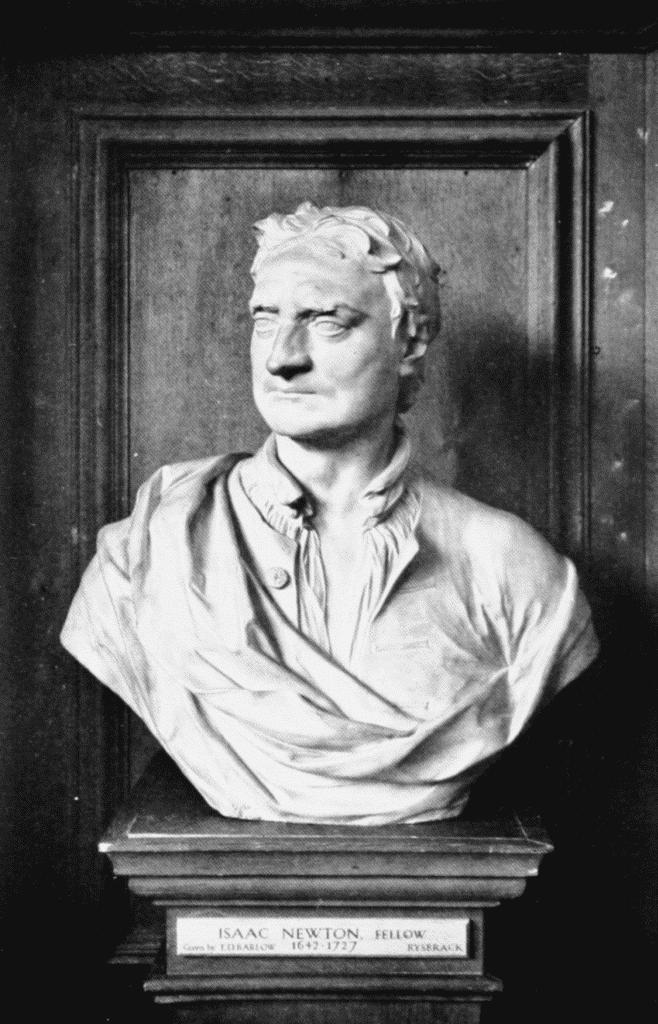
Isaac Newton
Michael Rysbrack
Plaster - it has been mistaken for terracotta in the past.
Trinity of College, Cambridge.
____________________________________






Text Below from British Museum Website.
On the basis of photographs Dr Katherine Eustace
does not believe that this bust is by Rysbrack; a terracotta bust by him in
Trinity College, Cambridge, dated 1739 appears to be the source for the Museum
plaster. Dawson 1999.
Displayed: c. 1756 'A busto of Sr. Isaac Newton
in plaister of Paris [with Dr. Mortimer]',
Recorded in Sloane Catalogue, no. 1985 (kept in the MLA Dept); 1817, removed from Mr Baber's department to over the bookcases in the Print Room (letter from J. T.Smith, 17 November 1817, P&D Dept Archive);
1847, possibly still in the Print Room as one of the 'Clays or Casts: a Large portion of them by Roubiliac' in Sir Henry Ellis's memorandum of 3 June 1847 (BM Central Archive Officers' Reports); 1881, probably still in the Print Room;(1) 1960, Dept of British and Medieval Antiquities (MLA dept record).
Recorded in Sloane Catalogue, no. 1985 (kept in the MLA Dept); 1817, removed from Mr Baber's department to over the bookcases in the Print Room (letter from J. T.Smith, 17 November 1817, P&D Dept Archive);
1847, possibly still in the Print Room as one of the 'Clays or Casts: a Large portion of them by Roubiliac' in Sir Henry Ellis's memorandum of 3 June 1847 (BM Central Archive Officers' Reports); 1881, probably still in the Print Room;(1) 1960, Dept of British and Medieval Antiquities (MLA dept record).
________________________________

Life size stone bust of Isaac Newton
Michael Rysbrack.
Circa 1729/ 30
Made for the Temple of Fame at Stowe designed by Gibbs
Moved to the Temple of Worthies, at Stowe in 1733.
__________________________________________________________
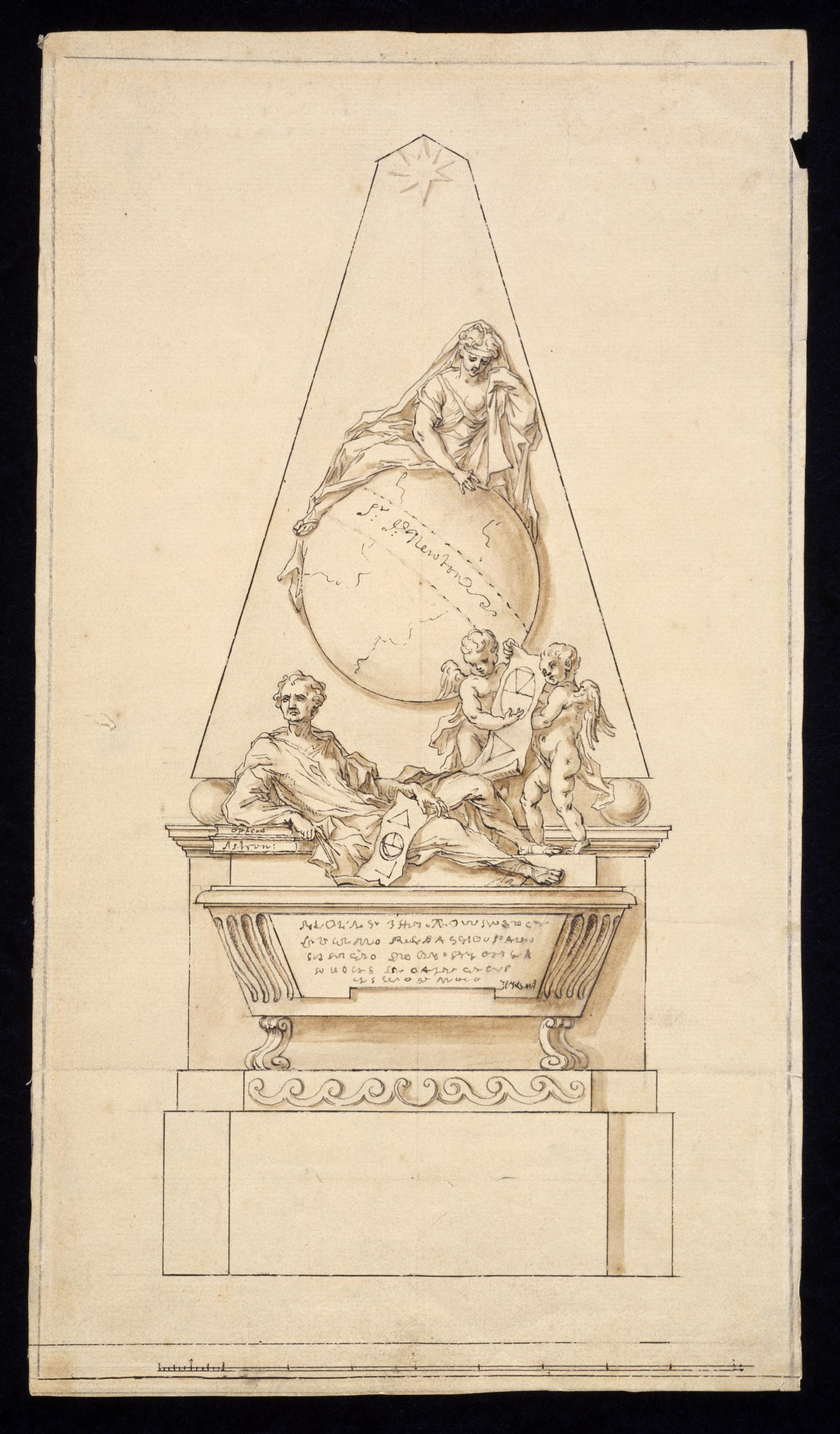
Design for the Monument of Isaac Newton
in Westminster Abbey.
by Michael Rysbrack
Designed and signed by William Kent
297 x 133 mm.
Victoria and Albert Museum.
_______________

The Monument to Isaac Neton
Designed by William Kent
this drawing by Michael Rysbrack
340 x 175 mm.
© The Trustees of the British Museum.
_____________________________________
_____________________________________

Engraving of the Kent Rysbrack Monument to Isaac Newton
From an unidentified book (Published after 1731).
218 x 175 mm.
© The Trustees of the British Museum.

_______________________________
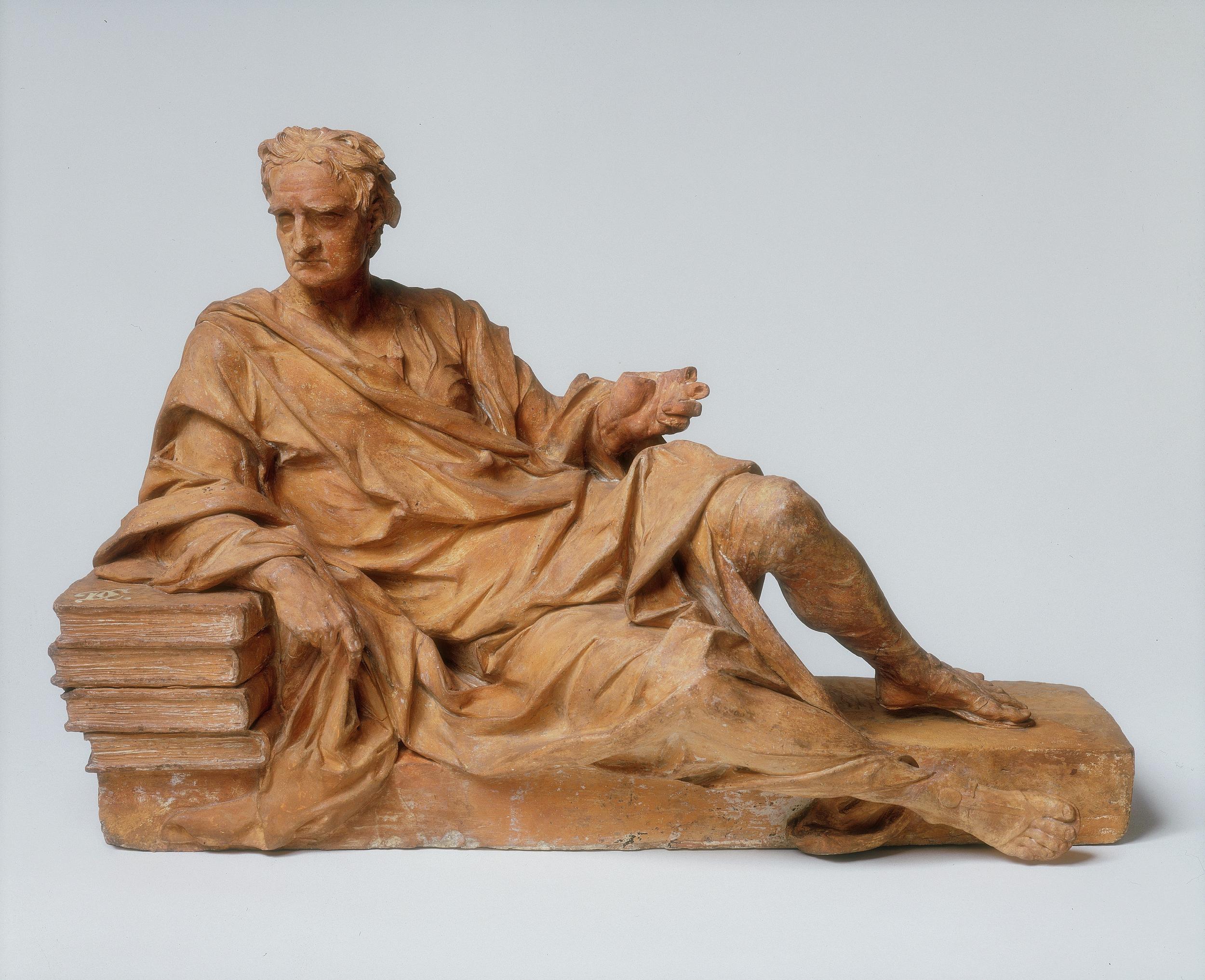
Terracotta Model of a reclining Isaac Newton by Michael Rysbrack
for the Monument in Westminster Abbey
Designed by William Kent
c. 1729.
36 x 53 x 23 cms.
Provenance
Rysbrack's retirement sale of 24/25 January 1766, Langford's Covent Garden.
First day sale, lot 42: 'Two ditto (figures) a sketch of Sir Isaac Newton, and a
Bishop' in a section headed 'MODELS', which seems to mean 3 dimensional models,
though not specified as terracotta.
Illustrated in a photograph of the Museum at Badger Hall, Shropshire, 1888
(National Monuments Record BB74/2928).
Previoulsy on loan to the
Museum by Dr. Hildburgh F.S.A. from 7 October 1945, and subsequently given by
him to the Museum as a New Year gift in 1938.
The V & A say -
Commissioned by John Conduitt (the husband of Newton's niece), terracottas such as this were already being
collected in the eighteenth century, and in the 1770s some of Rysbrack's models
for monuments in Westminster Abbey were advertised as "ideal for any library or
grotto."
_______________________________
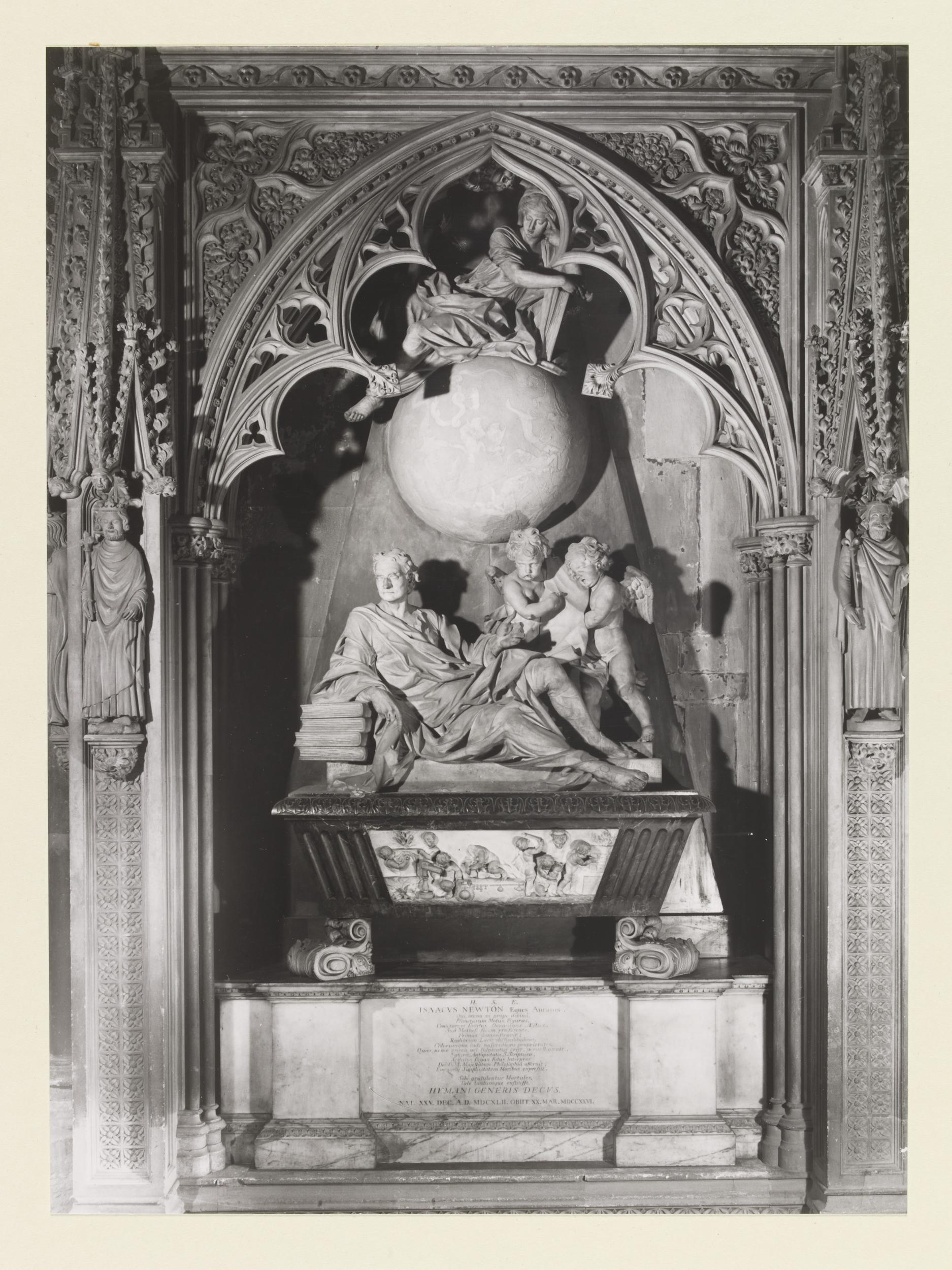
Old photograph.
"H. S. E. ISAACUS NEWTON Eques Auratus, / Qui,
animi vi prope divinâ, / Planetarum Motus, Figuras, / Cometarum semitas,
Oceanique Aestus. Suâ Mathesi facem praeferente / Primus demonstravit: /
Radiorum Lucis dissimilitudines, / Colorumque inde nascentium proprietates, /
Quas nemo antea vel suspicatus erat, pervestigavit. / Naturae, Antiquitatis, S.
Scripturae, / Sedulus, sagax, fidus Interpres / Dei O. M. Majestatem
Philosophiâ asseruit, / Evangelij Simplicitatem Moribus expressit. / Sibi
gratulentur Mortales, / Tale tantumque exstitisse / HUMANI GENERIS DECUS. /
NAT. XXV DEC. A.D. MDCXLII. OBIIT. XX. MAR. MDCCXXVI"
This can be translated as follows:
"Here is buried Isaac Newton, Knight, who by a
strength of mind almost divine, and mathematical principles peculiarly his own,
explored the course and figures of the planets, the paths of comets, the tides
of the sea, the dissimilarities in rays of light, and, what no other scholar
has previously imagined, the properties of the colours thus produced. Diligent,
sagacious and faithful, in his expositions of nature, antiquity and the holy
Scriptures, he vindicated by his philosophy the majesty of God mighty and good,
and expressed the simplicity of the Gospel in his manners. Mortals rejoice that
there has existed such and so great an ornament of the human race! He was born
on 25th December 1642, and died on 20th March 1726".
Aquatint by A. Pugin and T. Rowlandson.
Welcome Library
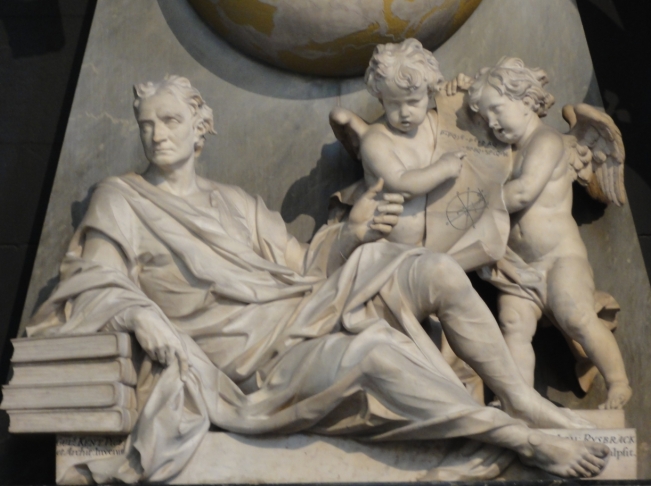
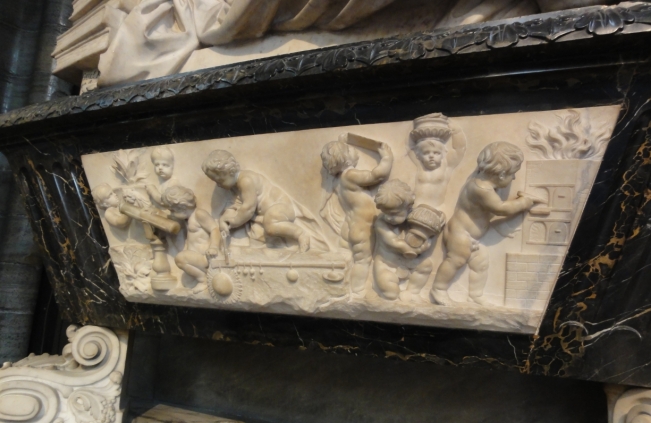
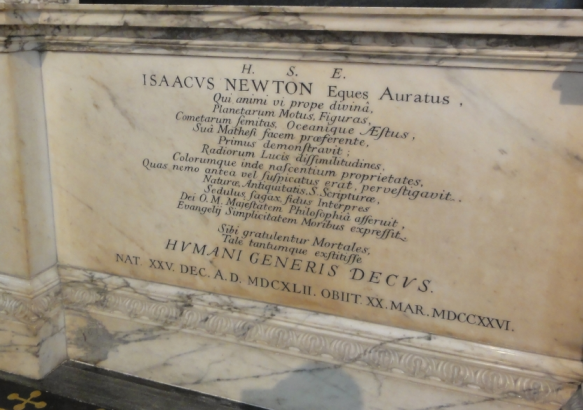
Photographs Courtesy -
This photograph courtesy -


Isaac Newton Bust
Engraved by George Bickham
352 x 251 mm.
1732.
British Museum.
_____________________________
_____________________________
Design for the Monument of Sir Isaac Newton
by Sebastiano Ricci
c.1728.
40.3 x 32.7 cm (sheet of paper).
______________________________________
Marco Ricci
dated 1728.
31.5 x 45.5 cms.
Gouache
Consul Joseph Smith at Venice, was Seb. Ricci's patron, and published at least two books connected with his
work via the Pasquali Press. Smith also commissioned a gouache of the same
subject by Marco Ricci (RCIN 400585) which is dated 1728. The monument is
similar to the tomb by the sculptor Michael Rysbrack to the designs of William
Kent in Westminster Abbey that was not completed until 1731.
Smith was in
contact with John Conduitt, husband of Newton's niece, who commissioned
the Rysbrack tomb and it is possible that he obtained preliminary sketches from
him that he passed on to the Riccis.
Smith was also well aware of the project embarked upon by the impresario and art dealer Owen McSwinny for a series of twenty-four allegorical tombs in celebration of great English men since the Revolution of 1688.
Newton's study of optics which was of interest to
painters, and his clarity of thought linked him to the contemporary
philosopher John Locke. McSwinny's project was launched from Smith's house in
Venice with Lord March in the 1720s.
It should be noted that the conception of this monument is not that far from the completed Westminster Abbey Monument by Michael Rysbrack in c 1732 which might suggest that Rysbrack was aware of it.
This entry was adapted from the Royal Collection website.
31.8 x 41.5 cms. approx.
- Both the Ricci Images courtesy -
________________________________________

Isaac Newton, aged 83.
Portrait by Vanderbank.
Engraved by George Vertue, 1725.
Frontispiece to 'Philosophiae Naturalis Principia Mathematica' (3rd ed. 1726).
215 x 150 mm.
© The Trustees of the British Museum.
Hogarth The Performance of the Indian Emperor
____________________________________
Lead Bust of Isaac Newton attributed to John Cheere.
27.9 x 17.8 x 8.3 cm.
Yale Centre for British Art
______________________

Death Mask of Isaac Newton
Huntington Library, California.



Death Mask of Isaac Newton
Royal Society.
_____________________________

Sir Isaac Newton
Engraving by John Faber after John Vanderbank
dated 1726.
351 mm x 255 mm - plate size.
© National Portrait Gallery, London.
_______________________

Isaac Newton after James Thornhill
Mezzotint by John Smith.
__________________________________
__________________________________

Isaac Newton
Engraving by George Vertue
After John Vanderbank
1726
240 mm x 183 mm paper size.
© National Portrait Gallery, London.
__________________________________
The Robert More Portrait of Isaac Newton
Enoch Seeman
Sold Christie's London 9th March 2016.
Enoch Seeman (circa 1694-1744) and Studio, Portrait of Sir Isaac Newton, Kt. (1642-1727), three-quarter-length, in a white cravat and green cloak, seated at a table with a copy of The Principia and an astrological globe.
Oil on canvas, 49 7/8 x 52 in. (126.7 x 132.1 cm.). Estimate: £25,000-40,000.
This lot is offered in Linley Hall, Shropshire: Property from the Collection of the Late Sir Jasper & Lady More on 9 March 2016, at Christie’s in London.
126.7 x 132.1 cm.
Notes from Christie's Catalogue:
Provenance - Robert More F.R.S. M.P. (1703-1780), and by descent at Linley Hall, Shropshire, to the present owner.
Milo Keynes, who dates the picture to 1726 (op. cit., p. 33), considers this to be the prime version of the portrait that exists in a number of versions, including those in the National Portrait Gallery, London, Trinity College, Cambridge, and Babson College, Massachusetts. John Ingamells (op. cit., p. 191), however, considers it likely that all were painted posthumously and derive from a bust-length portrait, dated 1726, by Seeman which is also preserved in the collection of Trinity College, Cambridge. Robert More, whilst not a direct contemporary of Newton, was also a fellow of the Royal Society (elected 1730), and a renowned bibliophile. More himself, whilst a young man, was also painted by Seeman and that portrait remains in the collection of the present vendor.
see - The Iconography of Isaac Newton, Milo Keynes 2005.
see - The Iconography of Isaac Newton, Milo Keynes 2005.

















